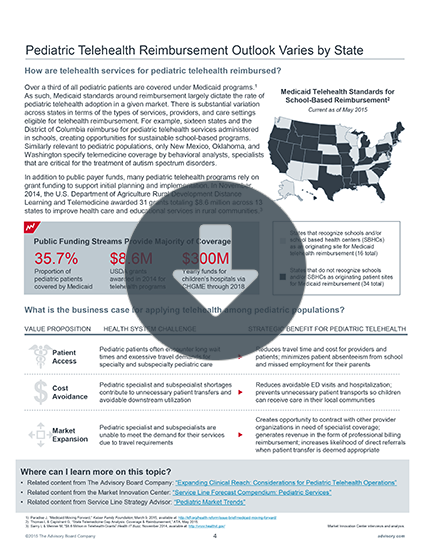Auto logout in seconds.
Continue LogoutValue-based care is a constant refrain in health care, but for children's hospitals, so far, the transition has been optional, and many have been shy to take on the financial risk. Writing for Healthcare Finance News, Jeff Lagasse reports on why Dayton Children's Hospital thinks the risk is worth it, and how the pediatric provider made the shift itself.
Cheat sheet: What you need to know about the ACA—and the value-based care landscape
Children's hospitals don't have to adopt value-based models (yet)
While CMS is pushing general acute care hospitals to adopt value-based models in Medicare, the shift isn't mandatory for children's hospitals, which have significantly lower Medicare volumes than hospitals that treat adults.
But some children's hospitals, such as Dayton Children's are making the shift early, Lagasse reports.
Why Dayton Children's is making the switch
Lisa Henderson, executive director of Dayton Children's, said the switch to value-based care is worth it because it's "the best thing to be doing for kids." For instance, Henderson said, value-based contracts encourage a "focu[s] on prevention" and can spur programs that "span the care continuum." She added, "There are a lot of organizations saying, 'The dollars will come, but this is what's best for the kids.'"
Unlike many pediatric hospitals, Dayton Children's employs pediatricians in its market, which meant the hospital was uniquely positioned to sit down with local doctors and talk about specific goals, what they'll do to meet them, and how to fund the process. That early engagement from pediatricians and primary care providers has been key, according to Henderson, in part because there aren't yet payer arrangements for pediatric care.
"In a lot of cases, the pediatric hospital is coming to the table with some of the dollars to get some of these programs off the ground," Henderson said. "Depending on the arrangement, there are rules on who can fund what in what situations. In our case, Dayton Children's said, 'This is really important, we want to tackle this model, and we understand the payer arrangements will likely come later.'"
What's to come?
Henderson said she expects more children's hospitals will adopt value-based care.
"Typically, in all of these national models, Medicare does it first, and eventually Medicaid will, and it'll take a little more time because Medicaid is driven state-by-state," she said. "But I think pediatrics is going to get there … [I]t's not the focus for a lot of organizations, but they're uniquely positioned to sort of set the tone. We can see what adult hospitals are doing, and it gives us an advantage."
Niki Buchanan, business leader for Philips Wellcentive, said, "If we're leaving out 20 to 30% of the population, children and adolescents, then all the health in adulthood doesn't have a benefit if we wait until they hit 21 years old."
According to Children's Health Alliance (CHA) Senior Director of Public Health Julie Harris, pediatrics is primed to adopt value-based care because of its existing focus on prevention. However, while preventive care has been a focus for providers, it's a change for payers, Harris added.
Deborah Rumsey, executive director of CHA, said one key to implementing value-based models in pediatric care will be making sure industry stakeholders invest in the right areas. "We really need to make sure the commercial marketplace is innovating. There's going to continue to be a shift, but if payment doesn't follow for many of these things we're investing in, it will be difficult to sustain," she said (Lagasse, Healthcare Finance, 3/28).
What you need to know about the ACA—and the value-based care landscape
The Patient Protection and Affordable Care Act, otherwise known as the ACA, is the comprehensive health care reform bill passed by Congress in March, 2010. The law reshapes the way health care is delivered and financed by transitioning providers from a volume-based fee-for-service system toward value-based care.
Download the ACA cheat sheet to get a quick overview of this significant U.S. health care legislation.
Don't miss out on the latest Advisory Board insights
Create your free account to access 1 resource, including the latest research and webinars.
Want access without creating an account?
You have 1 free members-only resource remaining this month.
1 free members-only resources remaining
1 free members-only resources remaining
You've reached your limit of free insights
Become a member to access all of Advisory Board's resources, events, and experts
Never miss out on the latest innovative health care content tailored to you.
Benefits include:
You've reached your limit of free insights
Become a member to access all of Advisory Board's resources, events, and experts
Never miss out on the latest innovative health care content tailored to you.
Benefits include:
This content is available through your Curated Research partnership with Advisory Board. Click on ‘view this resource’ to read the full piece
Email ask@advisory.com to learn more
Click on ‘Become a Member’ to learn about the benefits of a Full-Access partnership with Advisory Board
Never miss out on the latest innovative health care content tailored to you.
Benefits Include:
This is for members only. Learn more.
Click on ‘Become a Member’ to learn about the benefits of a Full-Access partnership with Advisory Board
Never miss out on the latest innovative health care content tailored to you.

